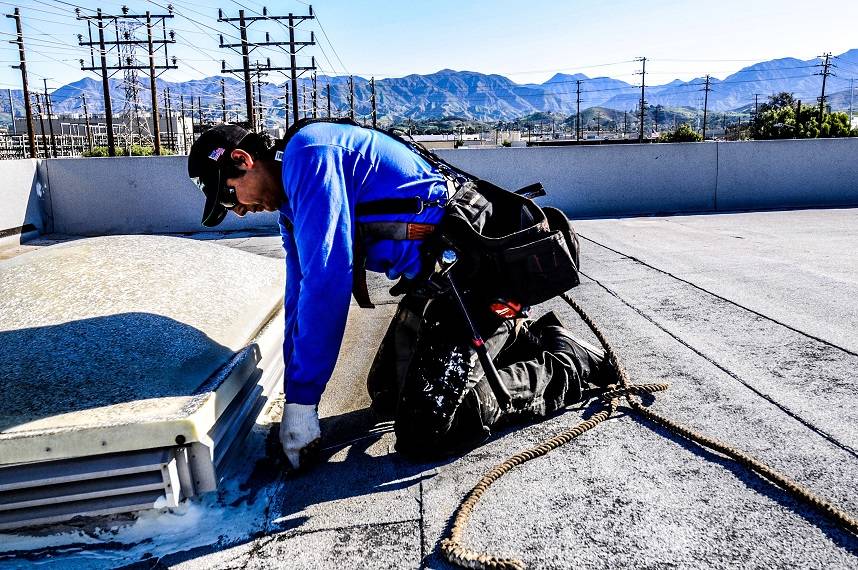At Central Roofing Company, we understand that a sturdy and reliable roof is crucial for the success and safety of your commercial property. Our team of highly skilled and trained roofing professionals is committed to delivering exceptional craftsmanship and superior service in every project we undertake.
8 New Pros And Cons About Modified Bitumen Flat Roofing
Here at Central Roofing, we see all types of roofing systems on flat roofs and one of the most common systems we see around Los Angeles is Modified Bitumen. Modified bitumen roofing has become increasingly popular in recent years.
And for good reason, but there are some things about Modified Bitumen that may not be so good. So keep reading, whether you’re a building owner, manager, or contractor, to learn the 8 Pros and Cons of Modified Bitumen Roofing
What is Modified Bitumen Flat Roofing (MBR)
Modified bitumen roofing is a type of asphalt roofing that is reinforced with modifiers such as rubber or plastic. This is a popular flat roofing system in Los Angeles because it is cost-effective, durable, and can withstand the hot and sunny climate. MBR is available in various colors and can be installed using different methods, such as torch-applied or self-adhesive.
Pros:
- Durability: It is highly durable and can withstand harsh weather conditions, including heavy rain, strong winds, and even hail. This makes it a popular choice for commercial and industrial buildings
- Affordability: Compared to other roofing options, Modified Bitumen Roofing is relatively affordable. The materials used are inexpensive, and the installation process is simple, which reduces labor costs.
- Easy installation: It’s easy to install, making it an ideal choice for new construction or roof replacement projects. The sheets are typically rolled onto the roof surface and then heat-sealed to create a waterproof membrane.
- Low maintenance: Requires minimal maintenance, making it a cost-effective option over time. With proper installation, it can last up to 20 years.
Cons:
- Limited design options: It’s only available in a limited range of colors and styles. This may not be suitable for those looking for a specific aesthetic for their building.
- Susceptible to punctures: Although durable, it is still susceptible to punctures from sharp objects or foot traffic. This may require periodic inspections and repairs.
- Not eco-friendly: It’s not an eco-friendly option as it is made from petroleum-based materials. This may not be suitable for those looking for more sustainable roofing options.
- Flammable: It’s flammable, which means it may not be suitable for buildings that require a high level of fire resistance.
Conclusion
In conclusion, modified bitumen flat roofing offers several advantages over traditional flat roofing materials, including greater durability, flexibility, and resistance to weathering and punctures. It also has some potential drawbacks, such as the need for regular maintenance and the potential for shrinkage and cracking over time. Ultimately, the decision to install modified bitumen roofing will depend on a variety of factors, including your budget, climate, and building type.
If you’re considering modified bitumen roofing for your commercial or residential building, it’s important to weigh these pros and cons carefully and consult with a roofing professional to determine whether this roofing material is right for your needs. With the right installation, maintenance, and care, modified bitumen roofing can provide a long-lasting and reliable roofing solution for your building.
In summary, Modified Bitumen Roofing is a durable, affordable, and easy-to-install flat roofing system. However, it may not be suitable for those looking for specific design options or more eco-friendly options. Additionally, it is susceptible to punctures and is flammable, which may not be suitable for all types of buildings.
Let’s Fix Your Roof Right — Get a Free Estimate Today
Serving Los Angeles & Orange County for 30+ years.
Trusted. Local. Professional.
Central Roofing Company Headquarters
555 W. 182nd Street
Gardena, CA 90248
📞 310-527-6770

Get A Quote
One of our roofing estimators will gladly meet you to discuss your options and follow up with a free, no-obligation, written estimate.
555 W. 182nd St. Gardena, CA 90248
Ph: 310-527-6770
Our Office Locations:
Our Services
CA license #684960 – Central Roofing, 2025 ©All Rights Reserved | Terms of Use | Privacy Policy | Built by Dymic